My friend ReTech created these sculptures. I find them profoundly unsettling, and hopefully you will too. Dread the mechanized infants…
Update: ReTech deleted the Imgur galleries, but I saved a couple of photos.
My friend ReTech created these sculptures. I find them profoundly unsettling, and hopefully you will too. Dread the mechanized infants…
Update: ReTech deleted the Imgur galleries, but I saved a couple of photos.
Cyberpunk sculptor Retech is looking for collaborators, and he asked me to spread the word. Here are the requirements:
And here is one of Retech’s pieces:
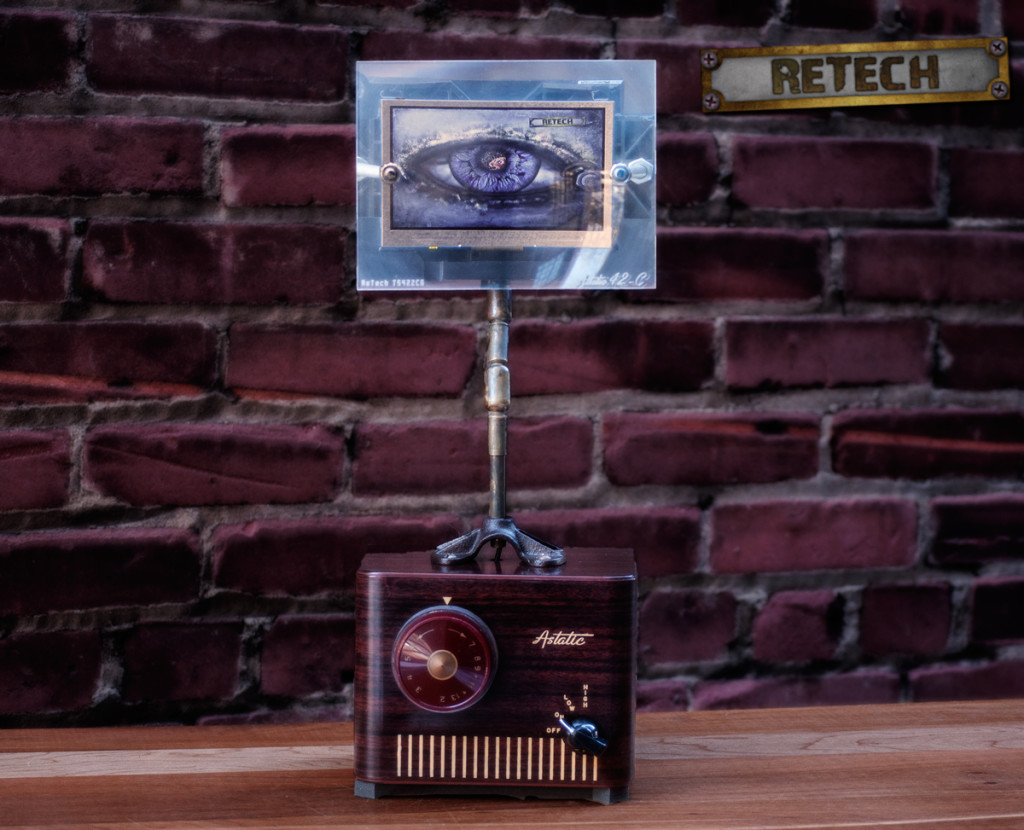
You can get in touch via Retech’s website. He requests, “If your message is urgent […] write the words: ‘TOP SECRET’ in the subject line. If your message is just commonplace then please write: ‘I am not a spambot or Nigerian scammer’ in the subject line.”
In other video-related news, tonight Alex and I watched Thomas in Love, a French movie that’s unintentionally retro-futurist. It came out in 2001. The filmmakers’ vision of the internet is a network of video services and “visiophones”, which are basically Skype devices. The protagonist is a thirty-something agoraphobic man whose life is controlled almost entirely by an insurance company — to which he voluntarily turned over his assets. His therapist signs him up for a video-based “dating club”, and Thomas falls in quasi-love with the first two women who pay genuine attention to him. This sounds like the setup for a dumb rom-com, but the movie is actually quite nuanced and definitely melancholy. Recommended for people who enjoy nonstandard storytelling forms, can tolerate French cinema, and also don’t need fast-paced plots to stay engaged.
The meta takeaway from Thomas in Love is that our own visions of the future will seem silly in just a couple of decades.
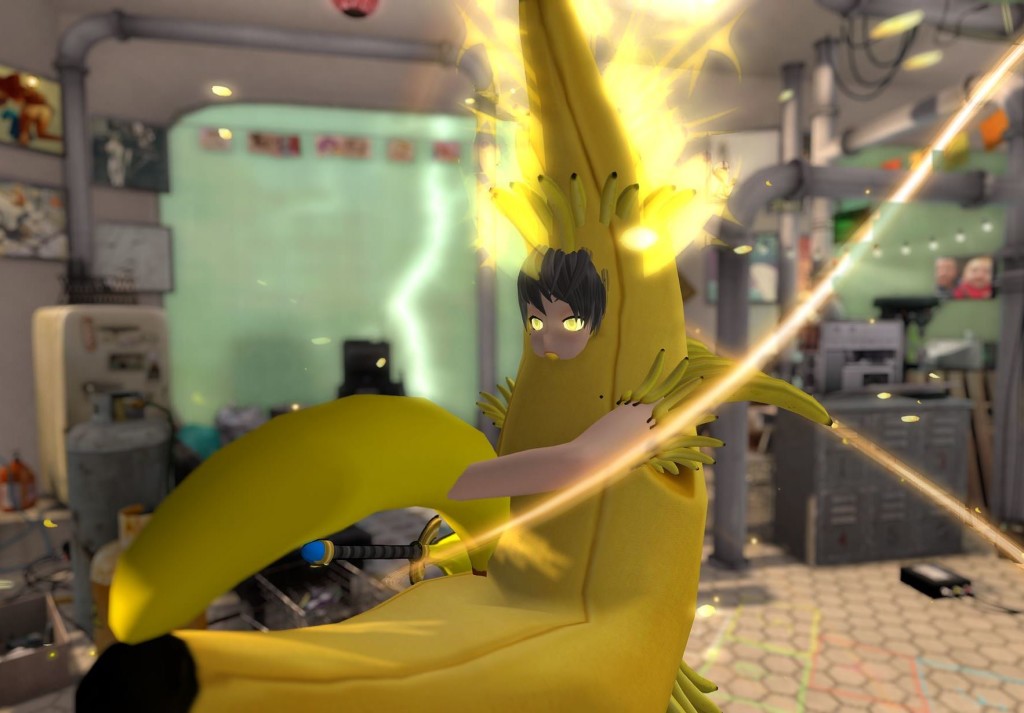
Image via ▓▒░ TORLEY ░▒▓.
I originally discovered Torley through Flickr, where he shares screenshots of ethereal and bizarre scenes from Second Life. He is also a musician and has released projects like Glitch Piano, an album described thus:
“Not long ago, in a parallel universe fairly, fairly close… humans imported a master race of sentient pianos through spacetime portals, using the instruments as labor-beasts and war-weapons. Predictably, these magnificent creatures rebelled and bass’ed civilization, enslaving the masses like the un-self-actualized lowminds they broadly are.
The contained aurelics (sonic artifacts) are historical evidence of such a traumatic time, and oddly, we detected halos of rich emotional spectrum — including loveliness and humorosity — amidst the runes.”
I emailed Torley to request an interview, and he answered my questions at great length. The full text, minus a couple of portions redacted for his privacy, is available as a PDF. The dispatch that you’re currently reading is a sort of “greatest hits” summary, like what I did with Andi McClure’s interview.
During a hard period in his life, Torley read some of the classic cyberpunk novels as balm. Consequently, he…
“wondered if there was a ‘real’ (as real as real can be) place where I could explore some of these ideas. I learned of the cyberpunk city ‘Nexus Prime’ in the Second Life virtual world — almost all content created by its users! — constructed on the aptly-named Gibson region […] As a metaphor that worked on such a practical level, my first avatar was an amplified version of my physical self, then I projected further into the future — and became an incarnation of my time-traveling daughter, who came back to tell me ‘THINGS ARE GOING TO BE OKAY’. […] Eventually, I was hired by Linden Lab (makers of Second Life), which I am immensely grateful for as it changed my first life even further. I continue to work here on all of their products, including Sansar — our next-generation virtual world.”
I asked about the appeal of this genre, and Torley told me:
“I’ve long romanticized big cities with towering skyscrapers, and couriers scurrying in the dark, running past neon signs with some data that was too precarious to simply upload… so it had to be done sneakernet-style. I definitely enjoy the whole audiovisual package, even if it’s the most superficial images of what comes to mind when a cyberpunk trope is mentioned… and as a strain of sci-fi, to quote Gibson, to realize we are living in an unevenly distributed future RIGHT NOW. It’s happening all around us.”
He continued:
“For me, cyberpunk has always meant giving unpopular (minority) ideas a fighting chance. […] it means a resistance to change the system, and augment one’s personal self. Which is what I chose with my life path. […] We each contain that power to alter the operation of the big machine, even if we may be ‘just’ a gear or cog in the works. Megacorps fascinate me, and all the fictional marketing that goes into the worldbuilding process.”
Torley on his own daily habits:
“I enjoy consuming Soylent 2.0 everyday. ‘Revolutionary’ is an adjective not to be applied lightly, but it’s saving me an accumulating amount of time. I always wake up and have a bottle or two to start my day. I’m drinking some as I communicate right now. A few bottles make up the majority of my meals. […] I suppose Soylent is a cyberpunk ethos foodstuff — the target demographics are both diverse and fascinating. Yet we are all human, and time is a teacher that kills all its students. That’s why I think their marketing is clever — they emphasize that Soylent does not outright replace conventional food, but FREES you to choose what meals you want to chew.”
Circling back to Second Life:
“Second Life has been a safe space for me and many others — whether that’s exploring identity, sexuality, racial-cultural constructs, etc. How you perceive SL depends on how you perceive yourself […] It’s very easy to experiment with identity here. You can change your whole look as easily as people can change clothes in ‘meatspace’. One’s avatar’s total appearance can be changed in mere seconds, yet may get a completely 180-degree response from those around you inworld. A hulking dragon brings out a totally different reaction than being an adorable pixie. I have been many forms, almost always revolving around my pink-and-green color scheme. I’ve called it ‘the Torley Council’, wherein I imagine a type of mini United Nations in my head, with each persona diverse yet unified — it’s all me, after all.”
In closing:
“We are blessed to live in such an age of technological abundance, as unstable as some systems may be. We owe it to ourselves to harness those tools to be healthier, happier, more creative human beings. When our own needs are met and our resources are replenished — and when we are genuinely comfortable in our own skin — we can more ably help each other.”
I’ll crack open a neon watermelon and toast to that.
Andi McClure is an artist whose primary medium is code. She uses proverbial `1`s and `0`s to make game-like creations, a programming language called Emily, and digital sigils. Andi and I chatted on Skype recently about these various projects and how she conceptualizes her work.
This conversation took place via IM. The full transcript is available for your reading pleasure, but it’s much too long for a newsletter. Instead, I selected some of Andi’s loveliest statements.
“Um, I guess I just had this drive to make stuff. I didn’t really question it. I guess at the beginning, when I was making things, I seemed focused on making worlds people could dip into? all my BASIC programs were grossly simple text adventures, and hypercard I was all making point and click adventures (it’s suited for that, it’s technically the program Myst was eventually made in)”
On the games Cyan made before Myst: “you’d explore these bizarre alice-in-wonderland worlds that were full of stuff that reacted in funny ways when you clicked on them.”
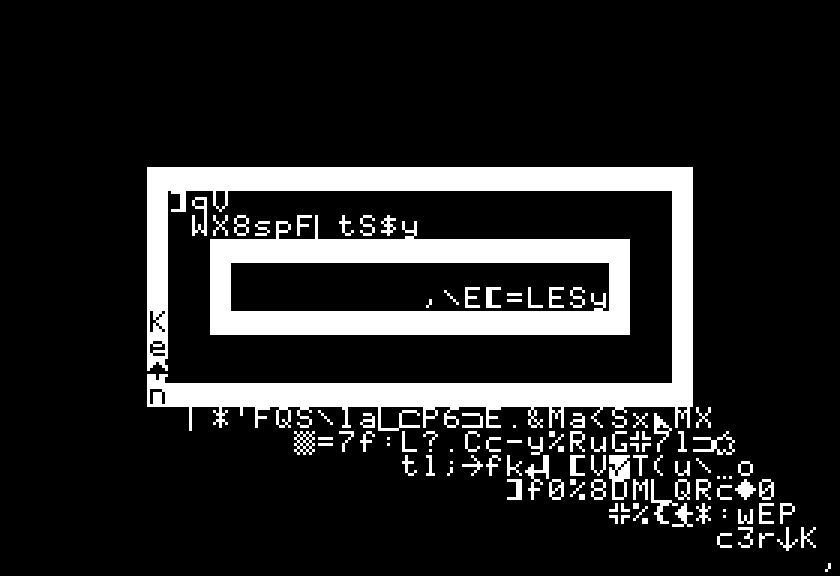
Cover art from McClure’s collection Sweet Nothings.
“I do definitely think of myself as an artist. Code happens to be the thing I know how to express myself through, so that’s how I create art. Sometimes I think of the way I approach certain things in life (politics, day to day problems) as being sort of an engineer’s mindset, but if i’m writing code, that’s art. My programming language project is maybe not itself art, but I’m doing it with the goal of making art WITH it, so.”
On trying to distribute “little minimally-interactive systems”: “I’d have this problem that the only way anyone could see this little bitty thing I made, that I spent like a day on and that takes about a minute to two minutes to appreciate fully, was to download this 2MB .exe, and run it on their computer, and half the time have to disable their antivirus or something. So that was awkward.”
The answer to that problem was a website called…
“dryads are trees that are also girls and that is very compelling to me.”
“i was very specifically trying to find something that evoked a sort of a tension between something organic and wild and something mathematical and technological. like some of the ones i didn’t go with were ‘glitch dot flowers’, ‘fleshy dot rocks’, ‘screaming dot computer’”
“i really really liked the idea of a dryad trying to design technology and what that would look like. i imagined that it would involve lots of crystals. i had this mental image of a tiny plant girl holding a wrench about as tall as she is, looking out over some kind of cryptic crystalline machine.”
“Again I’ve only got two things up so far but the descriptions are all going to be completely inaccurate descriptions as if the little toy I made was some sort of device built by dryads, with a specific purpose which is vaguely incomprehensible to humans but makes a lot of sense to a tree.”
“i do want to make sure this doesn’t feel like trees trying to use human technology and make sense of it. this is trees doing their own thing that may or may not have anything to do with you.”
Andi McClure is an artist whose main medium is code. She uses proverbial `1`s and `0`s to make games and game-like creations, a programming language called Emily, and digital sigils. Andi and I chatted on Skype recently about these various projects and her artistic practice(s).
This is the full transcript, which is messy like most IM conversations. I sent a collection of quotes to the newsletter subscribers. Read more
According to her website, “Addie Wagenknecht is an American artist based in Austria, whose work explores the tension between expression and technology. She seeks to blend conceptual work with traditional forms of hacking and sculpture.” She succeeds in this endeavor. I asked Addie some questions about her artistic philosophy.
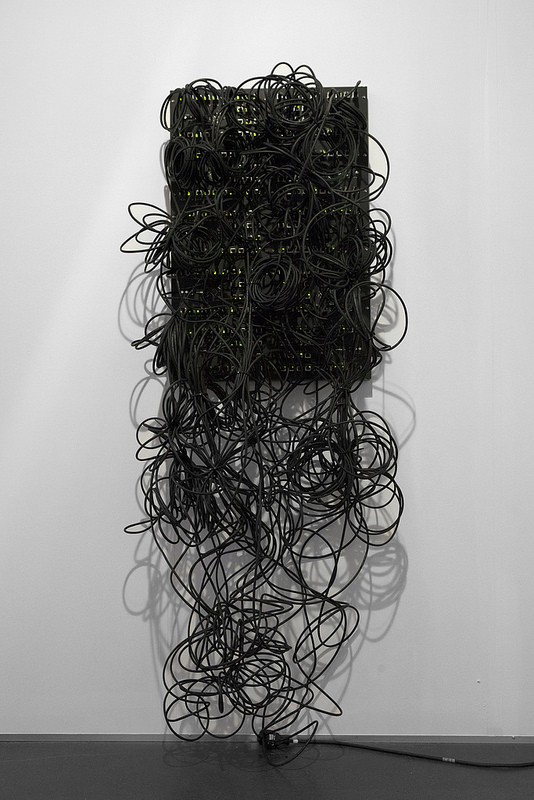
Artwork by Addie Wagenknecht.
Exolymph: Much of your body of work deals with surveillance, but I would go farther and say that you deal with the power differentials highlighted by acts of witnessing. Do you agree with that, or is it pseudo-intellectual bullshit? Either way, how do you feel about being watched?
Wagenknecht: Yes, I agree with that statement entirely.
Regarding being seen, being watched, there is a trauma to not being seen, as much as one exists for those being watched. Who is allowed in to the public sphere? Who is allowed to be visible? I have been reading a lot of research and papers on the implications of race/sex/religion within the canon of surveillance, as these factors serve as both a discursive and material practice of sociopolitical norms. Crypto is an inherently elitist technology; it is simply not available to people who are not highly fluent in their hardware and software bases. The more people outside of the hacker scene I teach these tools to, the more I believe how insanely secretive and elitist these so-called open protocols are.
Here is the thing: “public” has a reliance on the notion of a binary between private and public, visible and invisible space. This implies that we have spaces which are not part of this surveillance paradigm, but with the nature of smartphones being on everyone, everywhere, I am no longer convinced that this binary exists. “The personal is political” can also be read as saying, “The private is political.” Because everything we do in private is political: who we have sex with, what we eat, who does the cleaning, and so on…
Exolymph: How do you see your work evolving over time? What new themes interest you now?
Wagenknecht: I’d like to do more collaborative longer-term projects. I’ve started working with Peter Sunde on some small works which I hope we can release in the coming months, and also Quayola on interpretation of code as a visual entity.
My research in the last two months has been primarily about living in entirely man-made environments and the Internet of Things. The genesis of matter, the history of the earth, and how they are being reinterpreted as a form of speculated geology by the human race and the machines which we version-control that control us. I am also researching mineral composites, which would otherwise not be found in nature, to challenge definitions of “real”. I’m looking at how to play homage to the Western valuation of hyper-optimization by maximizing the believed properties of various specimens.
Exolymph: In general, what draws you to conceptual art? Why sculpture in particular? It’s interesting that you address digital realities in corporeal forms.
Wagenknecht: As artists, our role is to take complex ideas and encapsulate them in a way that society can parse. I want to subvert systems and objects in ways which people can hopefully better understand and reflect on why we need them at all.
Exolymph: What are you interested in building that you haven’t had a chance to do yet? What if you had unlimited resources?
Wagenknecht: I’d do more physical works that rely on fabricating with robotics and robotic arms, large-scale pieces, in materials like stone and metals. I also have some large-scale installations that I’ve been wanting to do forever and I’d get that list of works complete.
Exolymph: What have you downloaded that did get you in trouble? [I was referencing a piece that involves the sentence “I will not download things that get me in trouble” scrawled repeatedly across a wall.]
Wagenknecht: Ha! I’d prefer not to answer that.
Ways to get in touch with Addie Wagenknecht, as well as more examples of her artwork, are listed on her website.
Please liberate yourself from the need — or even the desire — to make sense. Stop producing sense. We have enough sense. There is a surplus of sense and you’re adding to it. Cease and desist! This is an order. Furthermore, we resent the implication that we’re begging you to obey. “Passionately requesting” is a better way to phrase it.
Artists propose more compelling futures than venture capitalists. However, like venture capitalists, artists are not good at actualizing their ideas (and many artists would cringe, rightly, to see their fantasies made flesh). Once again resembling venture capitalists, artists provide accelerant rather than fuel. They need an enterprising individual or organization to carry out the doing, to build the fire. George Orwell couldn’t have orchestrated the collapse of the Soviet Union or the rise of today’s surveillance state, but he provided a way for us to process both political turmoil and SIGINT.
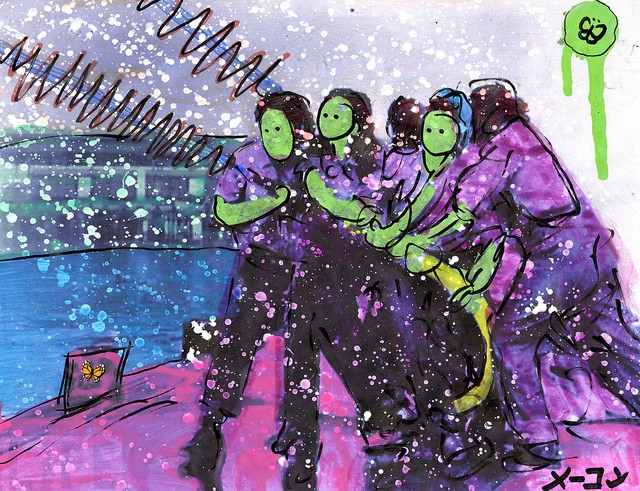
Artwork by Marc-Anthony Macon.
You’ll notice that my logic in that example is circumspect. Aren’t “accelerate” and “process” different verbs? It doesn’t matter, because I’ve released myself from sense-making tonight. I’m making something else, hopefully something more necessary.
“The gameworld is too complex and multi-dimensional to ensure every contingency is managed.” — The Tao of D&D
Of course I know that my free-form musing is self-indulgent. Reason is the hard thing, the valuable thing. But it’s difficult to maintain without an equal dose of nonsense. Material needs material. Analysis never exists without data, and I don’t think it can exist without randomness and play either. Our brains need a chance to seize on unexpected adjacencies.
Yet another reason to love Twitter bots 😉
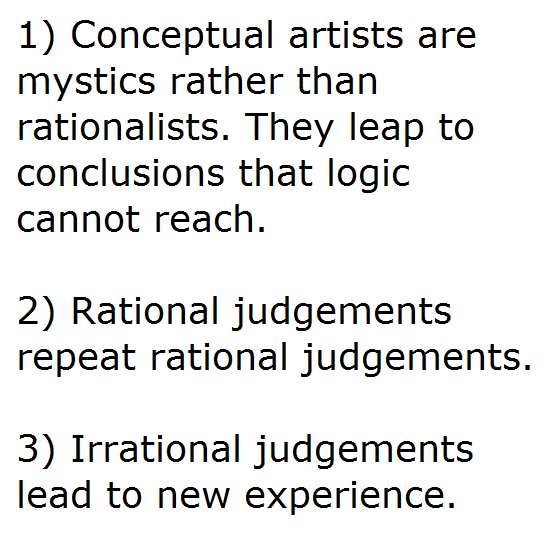
The first three of Sol Lewitt’s “Sentences on Conceptual Art”.
“If you’re doing something that nobody else is doing, it’s either really stupid or really smart. If it’s really stupid at least people will talk about it, but if it’s really smart you’ll have no competition.” Zach Gage on his creative process. He cited Lewitt’s “Sentences” as an influence.
So who is this guy, anyway? Zach Gage is a conceptual artist. His work encompasses “games, sculptures, websites, talks, prints, photos, videos, toys, hacks, fonts, installations, and more.” He is best-known for iOS apps like Ridiculous Fishing and SynthPond. I’m struggling to summarize Zach’s work in a way that encapsulates why I find it exciting. Maybe an example will help — my favorite of his creations is warorpeace.net:

The site can display either “WAR” or “PEACE”, depending on how many people Google each word in a given day. The most-searched of the two words will win. Zach explained, “On the day that more people search for peace than war, the site will say peace. As of this writing, that has never happened, but the work awaits the day it does.”
warorpeace.net is more of a pure conceptual piece, but Zach’s bread-and-butter is game design. That’s how he makes most of his money, and based on his list of complete works, interactive creations are an enduring interest. I think it’s important to talk about the paradigms and techniques employed by game designers, because they have power. As virtual reality continues to gain traction, we’ll spend larger portions of time in worlds programmed by other humans. (Not necessarily a bad thing!)
On Friday morning, Zach and I talked about designing generative systems that manage to keep surprising people — including the creators. (We agreed that Olivia Taters does a great job.) I asked why systems intrigue him, and Zach said, “I think one of the biggest things is that people just don’t understand systems. It’s kind of a complexity thing.” Therefore system design “provides kind of a good target for art and a good target for games.”
Like many artists, he wants to make people think. Most of the time, we default to a sophisticated kind of autopilot. Zach told me, “You start doing things by pattern recognition and you do a lot less sitting, thinking, and wondering.” It’s a natural reaction, because we all have to get on with our daily lives — but it’s also valuable to be snapped out of the monotony. Zach likes to observe the rules of systems that people are following by rote, and try upending one assumption. This is a way to interrogate how things work — to prompt people to question their own habits and processes.
“There are not a lot of ways you can build something that will ask people to think,” Zach said. When people puzzle through a game and solve problems, they stretch their neural muscles and often feel good about themselves, especially if the story was also beautifully immersive. However, providing this experience is extremely difficult. Zach told me, “Designing games is really hard. It’s really challenging. You’re trying to design something that you yourself could never fully understand, because that’s what’s fun about games.”
When Minecraft became a huge hit, a lot of people released copycat games. Zach contends that they imitated Minecraft aesthetically without reproducing the core magic. He explained to me, “When you deal with randomness, most of what you get is just a regression to the mean.” For example, “The longer you generate [procedural] landscapes, the more you realize that although technically every landscape is unique, they’re all the same.” Ho hum, another winding river and a few more snow-capped mountains. Even if the contours are a little different, the way we perceive the environments and interact with them is the same.
Zach thinks that Minecraft “did a really good job tying together the generative components with these actual functional components” in a way that allowed people to apply meanings that resonated with them. (I wish I had asked him to elaborate on how Minecraft does this better than others.) In his own work, Zach tries to build depth and profundity into systems that use random elements. Zach wants to “make sure that [players] are engaging in the way that the stuff is the most interesting.” This is a tricky design problem, but he seems to be tackling it well.
© 2019 Exolymph. All rights reserved.
Theme by Anders Norén.